WHAT'S NEW:
BACKGROUND:
Mission
Project Description
Cruise Plans:
Participants
Technology (ROV, ships, etc.)
Future Plans
Results:
1998 NeMO Cruise
Axial 1998 "Eruption"
Logbook
July 10, 1999
July 10, 1999
Contents:
- News from Thompson
- Participant Perspective
- Logbook from Teacher at Sea
- Question/Answer from shore to sea
Thompson Science Report
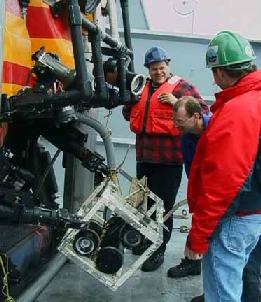 Time-lapse camera deployed at Marker 33 for one year in 1998 and 1999, documenting the colonization of animals at the eruption site. |
Ships Location: 45 55.2/129 59.6
After ROPOS dive 500 came up this morning, we recovered the navigation transponders that we had put down earlier in the cruise. ROPOS dive 501 then deployed the time lapse camera at Marker 33 where it will stay for another year, and then ROPOS started a series of geologic traverses to better define the extent of the 1998 lava flow just south of the area we mapped last year. We think some of the southern-most vent sites we have found (Marker 113, Joystick vent, and Bag City,) are actually located along the eruptive fissure of a very young, but pre-1998 lava flow. This young lava flow is difficult to distinguish from the 1998 lava, so we will be making careful traverses to map out the transitions from one lava flow to another. This will help us better constrain the volume of the 1998 eruption. Also, knowing the age of the lavas in which each vent is located is critical information for interpreting their chemistry and biology.
Listing of all Science News postings
Life at Sea: Participant Perspective
Andy Graham
University of Washington
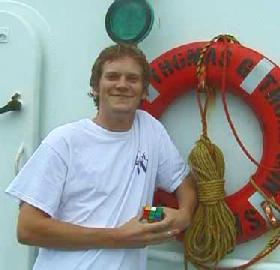 Up to this point
the cruise has been relatively stress-free for me as compared to some
of the other scientists on the cruise. I am a technician in a chemical
oceanography lab at the University of Washington, so unlike the other
scientists and graduate students on the ship I do not have a major project
I am working on. I am here to analyze the samples that we do get and others
will use the data I collect in their own projects.
Up to this point
the cruise has been relatively stress-free for me as compared to some
of the other scientists on the cruise. I am a technician in a chemical
oceanography lab at the University of Washington, so unlike the other
scientists and graduate students on the ship I do not have a major project
I am working on. I am here to analyze the samples that we do get and others
will use the data I collect in their own projects.
I am using a gas chromatograph to analyze vent fluid samples for dissolved hydrogen and methane gases. These gases are important in vent fluid chemistry because both can be used as sources of energy for microbes. By oxidizing either hydrogen or methane the microbes are able to grow and thrive. It is because of these, and other energy sources that the diverse biology found around vent site is able to survive without photosynthesis.
I graduated from the University of Washington with a B.S. in chemical oceanography last year and was offered this job as a "tech" by a professor of mine. I have found this job an invaluable learning experience in that I have been able to work and learn along side many top scientists in the field of hydrothermal vents. Plus, due to the experiences this job has offered me, I have decided to attend graduate school in oceanography. This is the second cruise I have been on as a "tech", the first was to the Southeast Pacific Rise where I was performing pretty much the same function as I am on this cruise.
Like most of the others on the cruise I have filled in the down time with movies, ping pong, and the Rubix cube that Maia brought along. I have gotten quite skillful at the cube, thanks to my master Maia, of course this is a skill I learned about 15 years too late since Rubix cubes aren't quite as poplar as they were back in the mid 1980s.
Listing of all Perspectives postings
Teacher At Sea Logbook
Teacher Log #19 7/10/99
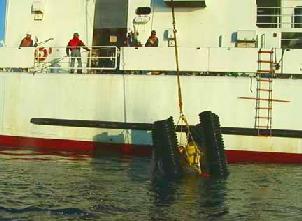 The elevator, positively buoyant in the water without its weights. |
When an object is placed in water, there are two forces acting upon it. One force (gravity) pushes down while the other (buoyancy) pushes up. Which ever force is greatest determines whether floating or sinking occurs. The balance between the two forces can depend on the volume, shape and weight of the object. Buoyancy is related to the weight of the water displaced by the object being submerged. When an object's weight is less then that of the water it displaces, it is said to be positively buoyant. It then floats, as our elevator and transponders do. When the opposite occurs, sinking takes place. So, what does this have to do with what's going on out here?
Each time ROPOS is prepared for a dive, the weight of the ROV and all equipment used must be determined so that ROPOS can remain positively buoyant. Anytime a new piece of equipment is used, it is hooked to spring scale and lowered into the water to determine what it weighs in water. Adjustments are then made on ROPOS. Lead weights attached to the ROVs sled pads are removed or added depending on the payload. It is also important to maintain ROPOS's trim or balance while in the water. Too much weight one side or the other, and it will be tilted. One of our dives this month was ended early for this reason. When under water, a careful eye is kept on the cumulative weight of the fluid, geological and biological samples that are being collected. Positive buoyancy of the ROV is important if for some reason it were to become disconnected from the cage, due to its positive buoyancy, it would slowly float back to the surface where a recovery could be made. This happened back in October of 1996, when during a storm, ROPOS's tether snapped. It was spotted at the surface but due to the tenacity of the storm, was never recovered. When ROPOS is at the bottom, thrusters are needed to keep it down just as a swimmer must keep using energy to stay below the surface. The cage that ROPOS is housed in is negatively buoyant. It sinks when placed in the water. In fact, its negative buoyancy is used to help pull the cable that is unwound by the winch. Scuba divers try to stay neutrally buoyant and use buoyancy compensators to develop a balance between the upward and downward forces. This allows a diver to maintain a desired depth, thus saving the energy normally exerted for staying down.
So you can see how controlling the buoyancy of oceanographic equipment is very important. You need to get your instruments to sink to the bottom, but you also want to be able to get them back again. For tomorrow, think about how modern ships which are made of metal (far more dense then water) are made so as to create positive buoyancy. We'll talk tomorrow about the mysterious shrinking heads.
Bye for now.
Logbook of all Teacher At Sea postings
Questions & Answers
Questions from the Wallace family:
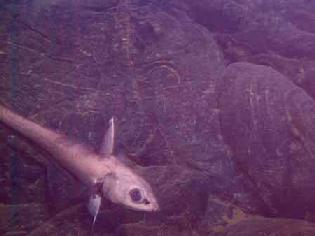
(Christopher, age 7) Q: I would like to know how big the rat tail fish
(photo right) get at the vents and how they can live in these hot temperatures when
other fish can't.
A: Rattail fish can get up to at least three feet in length. Although
they are found near hydrothermal vents, they don't actually live in the
vent waters and are not specifically associated with vents. They are one
of the few deep water species of fish, and so it is common to see them at
these sites.
(Lauren, almost 5) Q: I want to learn more about
tube worms. I saw
baby tube worms at Botanical Beach. Do the baby worms come from egg
sacks?
A; What you probably say was an intertidal marine worm (polycheate) called
a serpulid. These worms reproduce by releasing eggs and sperm into the
water column. The sperm fertilizes the egg to create a "planktotrphic"
(living in the water column) larvae. The larvae will eventually settle on
the bottom and the worms will grow and secrete its tube. These
serpulids are very different from deep-sea tube worms which are actually
not polycheates, but vestimentiferans.
(Susan, "mom")Q: If oxygen destroys most of the bacteria you collect does that
eliminate the possibility of finding any viable pathogenic bacteria? Do
the precautions you take to ensure protection of the specimens also ensure
your protection in the event that they could survive in this environment?
A: First, Oxygen doesnt actually destroy most bacteria, it just inhibits
anaerobic bacteria from growing. Second, due to the selective pressure
and the nature of the extreme environments like hydrothermal vents,
pathogens are unable to grow. Bacteria that have a chemosynthetic
metabolism such as the ones that live at hydrothermal vents are not
pathogenic, though some have been found that produce antibiotics.
Questions from the HMSC auditorium audience:
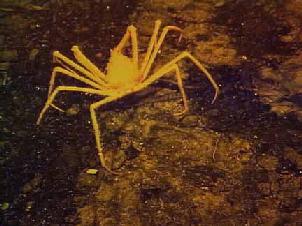 Q: Do they
know what species of crab it was that was captured on dive R498 and what
is known about its life history? How big is it and what was done with
it?
Q: Do they
know what species of crab it was that was captured on dive R498 and what
is known about its life history? How big is it and what was done with
it?
A: The crab captured on dive R488 (not 498) (photo left) is an unknown species. Like many vent
creatures, not much is known other then what is observed when it was
captured and studied while in the lab. This specimen was about 6 inches
(15 cm) in diameter. Upon reaching the lab the specimen had its 3rd left
walking leg removed and the rest was prepared for transfer to the
Chicago
Field Museum of Natural History for identification. The leg removed will
be analyzed for stable isotopes and lipid biomarkers. These will be used
to determine what part in the hydrothermal vent ecosytem food web it is
part of.
Q: How do they look for signatures of the food web in the animals tissues?
A: By knowing specifically what organisms feed on and are consumed
themselves, researchers hope to find basic compounds from one organism in
those that ate them. Researchers use certain isotopes (elements with
different atomic masses) as markers, and then try to identify them through
the pathway of the web. They use the fatty acids that make lipids in the
same manner. Samples tissue from organism is ground up and analyzed using
some extremely complex equipment. Based on the amounts of these specific
elements and building block compounds found, it is possible to theorize
which organism is the food for another.
Q: Are all hyperthermophiles classified as Archaea? Is the Moneran
classification used anymore?
A: Most of the hyperthermophilic microbes are classified as part of the
Archaea grouping. One group though is still part of the Bacteria group.
The Moneran classification is no longer used by most microbiologists. In
fact, the whole system of classification is undergoing some revamping, so
maybe in a few years the picture will be clearer.
Q: Recently, Canada established the
Endeavor segment of the Juan da Fuca
ridge as a
Marine Protected Area. How do those scientists on the cruise feel about
this?
A: The feeling on board is one of agreement with this tactic, in
principle. Concerns center on the constraints that will be applied to
this area with regards toward ongoing research at this location. This area
of the Juan de Fuca Ridge is one of the most vigorous and diverse
geological hydrothermal vent systems. It has yet to be determined what
regulations will be set in regards to research and sample collection. For
now they will wait and see what the next step is.
Q: Is there any chance that Axial Volcano will become a Marine Protected Area
like the Endeavor
Segment?
A:Axial volcano is in international water (it is outside the 200 mile
limit) there is no mechanism for such a move. The Endeavor segment falls
within Canada's 200 mile Exclusive Economic Zone, so they have the rights
to it.
All Questions/Answers from sea
![]() Send Your Question to NeMO
Send Your Question to NeMO
(oar.pmel.vents.webmaster@noaa.gov)